- Home
- Council
- Regulatory Control
- Services
- Projects
- Your Community
- Investment
- Phone: 02 6924 8100
- Home
- Council
- Regulatory Control
- Services
- Projects
- Your Community
- Investment
Urban Salinity – A Case Study of Junee Shire Council
by Col Macaulay
Director Engineering Services
Junee – Location and Description
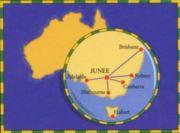 Junee is a town with a population of 4,000 people, located in south-west New South Wales, 450kms from Sydney and 550kms from Melbourne.
Junee is a town with a population of 4,000 people, located in south-west New South Wales, 450kms from Sydney and 550kms from Melbourne.
The normal rainfall for Junee is approximately 500mm per annum which is distributed evenly over the twelve months of the year – the Summer rain falling as storms with Winter rainfall being more gentle and soaking.
Junee is made up of seven catchments with all of these feeding into the central part of storm water moving through Junee and then travelling to the north to meet up with the Houlaghans Creek, which is one of the two major water collection systems within the Junee Shire. Houlaghans Creek eventually runs into the Murrumbidgee River just west of Wagga Wagga, 40km away.
Junee’s geography is such that it is surrounded by granite hills with the township being located in the naturally formed valley along an ephemeral water course.
There are two reasons for the town being located where it is, namely:
 1. In 1878 the railway was surveyed through the valley to avoid the steeper hills located to the east and to the west; and
1. In 1878 the railway was surveyed through the valley to avoid the steeper hills located to the east and to the west; and
2. Due to there being a source of water, the town developed along the railway line with several wells being dug along the ephemeral water course to enable a very basic and crude water supply system to be installed.
From photographic evidence of one of these wells, it could be estimated that the well has been dug to a depth of probably four to six metres to obtain water. The water was then sold to the towns folk by the bucketful.
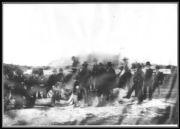 Junee is what I would consider a ‘text book case’ that shows the movement of water from the high rocky outcrops on each side of the valley down to the sedimentary layers along the water course, which is where Junee is located. The granite outcrops around Junee are highly porous, with water being absorbed readily and moving down the slopes through the sedimentary layers – caused by millions of years of erosion – to eventually be located and held in those layers underneath the township of Junee.
Junee is what I would consider a ‘text book case’ that shows the movement of water from the high rocky outcrops on each side of the valley down to the sedimentary layers along the water course, which is where Junee is located. The granite outcrops around Junee are highly porous, with water being absorbed readily and moving down the slopes through the sedimentary layers – caused by millions of years of erosion – to eventually be located and held in those layers underneath the township of Junee.
Probably what makes Junee unique from other areas is that there is evidence that the granite rock underlying the sediments has a natural ridge to the northern end of town which acts like an underground dam, holding back the silts and sediments that have eroded into the valley over millions of years. But, also holding back any excess flow of ground water that would naturally make its way underground following the natural steam until it eventually makes its way into Houlaghans Creek and then the Murrumbidgee River. This natural ‘bottleneck’ at the northern extremity of town exacerbates the water table issues to the south and within the township of Junee.
What is Urban Salinity and its Affect on Local Government and its Infrastructure?
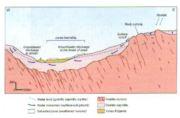 Urban salinity refers to the processes that cause, and the impacts that result from, the mobilisation and re-distribution of salt in urban environments. Vegetation composition, cover and health, patterns of water use, additional sources of salt, and the design, construction and maintenance of infrastructure can all contribute to urban salinity. These changes can alter the natural water cycle, inhibit drainage and impede ground water flow. Surrounding land use and geology can also add to the complex array of local or site specific issues as these factors also influence recharge rates, water movement and ground water discharge.
Urban salinity refers to the processes that cause, and the impacts that result from, the mobilisation and re-distribution of salt in urban environments. Vegetation composition, cover and health, patterns of water use, additional sources of salt, and the design, construction and maintenance of infrastructure can all contribute to urban salinity. These changes can alter the natural water cycle, inhibit drainage and impede ground water flow. Surrounding land use and geology can also add to the complex array of local or site specific issues as these factors also influence recharge rates, water movement and ground water discharge.
High saline water tables or saline water supplies in urban areas can lead to saline discharge sites, damaged buildings and fixtures, and damage to Council’s infrastructure. For Local Government and other urban stakeholders, this translates to additional costs associated with extra repairs and maintenance, reduced life span of infrastructure, preventative action and increased operating costs.
The infrastructure that I am referring to is:
 At Junee Council we have found that the effect of urban salinity on roads usually revolves around the fact that roads built in the higher water table areas do not last near as long as they should. That is, we have found roads constructed within the last ten to fifteen years are already showing signs of deterioration and there is a need to do extensive maintenance and (in some cases) re-construction.
At Junee Council we have found that the effect of urban salinity on roads usually revolves around the fact that roads built in the higher water table areas do not last near as long as they should. That is, we have found roads constructed within the last ten to fifteen years are already showing signs of deterioration and there is a need to do extensive maintenance and (in some cases) re-construction.
Some of the obvious effects that we see is the road deforming, especially where there is heavy traffic. These deformations can be so extreme that Council needs to take preventative action by grading off the deformations to avoid small cars having their sumps ripped out as they travel along the road.
Pothole patching increases in this scenario as well as the need for more regular re-seals. Carrying out re-seals can actually create problems with a road that is already suffering from urban salinity and high water table. Council has observed, on several occasions, that a road due for re-seal can have the appearance of being wet early in the morning, even through summer-time when there has been no rainfall for several weeks.
Council proceeds to carry out the re-seal and then finds, within a matter of months, that the road deteriorates and falls to pieces and then requires rehabilitation or, at least, extensive patching. Our theory for what is happening here is that the old seal was extensively oxidised and cracked which allowed excessive moisture build-up in the sub-grade layers of the road to evaporate due to the natural process of heating by the sun. The re-seal, however, seals the cracks and makes the surface of the road impervious. The effect of this is that the road sub-grades build up in moisture to the point where their strength is deteriorated and the road can no longer carry the loads that are imposed on it and it fails.
2. Parks and Gardens
 Junee Shire Council has battled for quite some years now in an attempt to proliferate parks, gardens and sporting fields knowing full well that, in some cases, the saline water table is within two or three hundred millimetres of the surface. The first effects, of course, are non-proliferation of plant species to the ultimate effect of salt scalding which totally denudes large areas of ground.
Junee Shire Council has battled for quite some years now in an attempt to proliferate parks, gardens and sporting fields knowing full well that, in some cases, the saline water table is within two or three hundred millimetres of the surface. The first effects, of course, are non-proliferation of plant species to the ultimate effect of salt scalding which totally denudes large areas of ground.
Council initially attempted to attack this problem by searching out species of plants that can endure the harsh saline environment of a high water table. However, after many attempts with trial species by consultants and contractors – who all thought that they had the answer- this was unsuccessful. It appeared
that nothing was going to work and in 1997, Junee sports fields were reportedly written off by the experts in that they would not be playable within a few more years.
Council briefly considered a de-watering project which has been carried out in other council areas, however, being a small rural shire, the affordability of constructing the bores and the on-going cost of pumping the water – along with the added problems of what to do with the water through evaporation basins etc. – was out of the question, financially and through lack of resources and physical ability to carry out the work.
Council has had to develop techniques to manage the high water table aspects of its parks and gardens. I’ll discuss these further on in the presentation.
3. Sewerage Systems
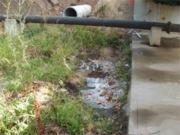 Junee Shire Council is probably more fortunate than most councils in that its sewerage system, which was built in the 1930s, was primarily constructed from concrete pipes which, after seventy years, have shown that their durability is unsurpassed by any other product at this time.
Junee Shire Council is probably more fortunate than most councils in that its sewerage system, which was built in the 1930s, was primarily constructed from concrete pipes which, after seventy years, have shown that their durability is unsurpassed by any other product at this time.
Council does not have a lot of evidence to suggest that the high water table is affecting its sewerage system but more work is planned to be done using cameras and flow analysis to determine how extensive the problem actually is. Junee Council, like most, records a far greater rate of inflow to the sewage treatment works during high periods of rainfall. However, at this stage, most of that is attributed to illegal storm water connections.
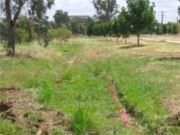 Council has found that the most affect that the high water table and salinity has on its storm water network is that any area which is not concrete-lined, V-drained or piped usually becomes a Cumbungi-ridden mess, with the major problem being that it is impossible to clean out the drains because of the boggy and wet situations that persist because of the high water table – remembering that most drains intersect the water table.
Council has found that the most affect that the high water table and salinity has on its storm water network is that any area which is not concrete-lined, V-drained or piped usually becomes a Cumbungi-ridden mess, with the major problem being that it is impossible to clean out the drains because of the boggy and wet situations that persist because of the high water table – remembering that most drains intersect the water table.
As a result of the Cumbungi growth in the drains, this has a multiplying effect within the constructed concrete and pipe drain network in that siltation occurs and major flooding can occur because water cannot get away, due to the clogged nature of the storm water system.
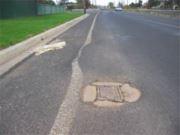 Junee Shire Council does not control its potable water network. That is controlled by Goldenfields Water County Council. However, Council is often involved by the fact that road damage is evident and the cause can quite often be traced back to a leaking hydrant, valve or gibault joint that has been rusted apart by the high saline water table. This creates the extra problem, of course, of adding to the water table itself with the leaking water main.
Junee Shire Council does not control its potable water network. That is controlled by Goldenfields Water County Council. However, Council is often involved by the fact that road damage is evident and the cause can quite often be traced back to a leaking hydrant, valve or gibault joint that has been rusted apart by the high saline water table. This creates the extra problem, of course, of adding to the water table itself with the leaking water main.
 There is considerable evidence around Junee of building degeneration caused by the high saline water table. Brick buildings are most affected with mortar disintegrating between brick joints which, if not maintained, can cause collapse of buildings.
There is considerable evidence around Junee of building degeneration caused by the high saline water table. Brick buildings are most affected with mortar disintegrating between brick joints which, if not maintained, can cause collapse of buildings.
Foundations are also affected. Timber piers rot more quickly than normal due to dampness under floors and there is deterioration of piping and other infrastructure installed under the buildings. Settlement and cracking are also obvious effects of buildings built close to the water table.
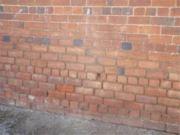 A good example of how rising water table and salinity can have an affect on major building projects is seen with the construction of the new Junee Hospital, which commenced several months ago. The site chosen for the hospital was a level site, close to the centre of town, and was once Junee’s soccer fields which had scalding and high water problems during the past ten to fifteen years.
A good example of how rising water table and salinity can have an affect on major building projects is seen with the construction of the new Junee Hospital, which commenced several months ago. The site chosen for the hospital was a level site, close to the centre of town, and was once Junee’s soccer fields which had scalding and high water problems during the past ten to fifteen years.
The floor level for the new hospital was established by the Dept. of Commerce and Greater Southern Area Health Service to satisfy the local ‘one in a hundred year’ flood criteria. However, they took no account of the fact that the water table was within one metre of the surface.
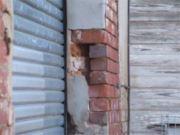 The design and construct project contractors were given a floor level and then told to ‘construct the hospital at that floor level’. Council officers, with all their knowledge of water table issues in that area, tried to convince the Dept. of Commerce that the hospital was being built too low and that they would have problems trying to establish foundations for the hospital.
The design and construct project contractors were given a floor level and then told to ‘construct the hospital at that floor level’. Council officers, with all their knowledge of water table issues in that area, tried to convince the Dept. of Commerce that the hospital was being built too low and that they would have problems trying to establish foundations for the hospital.
The Dept. of Commerce decided not to take that advice, and persisted with the hospital level that they had established – even after considering the quote from Junee Shire Council to the construction company for a mere $50,000 to raise the floor level of the hospital a half a metre.
Junee Shire Council was the successful tenderer for the bulk earthworks and establishment of the slab for the construction of the hospital. During the course of establishment of the bench and road works, bad ground was encountered and the cost to dig out up to 1.2m of depth and replace this material was $80,000. This expense could have been spared and a better result obtained by raising the hospital floor level.
What are the Sources of Recharge in an Urban Environment?
Sources of recharge in urban areas, in addition to rainfall, include:
Vegetation type, cover and health, and the design and management of public and private open space areas can also significantly affect the amount of recharge that occurs in an urban landscape.
Management Practices which Minimise Recharge in an Urban Environment
Following is a list of management practices that will reduce the recharge effect of urbanisation.
1. Road Construction
Junee Council has found that as the water table problem increases, special considerations need to be given to any road works that are being done in high water table areas. To date, we have tended to build roads with a deeper pavement in an attempt to carry the loadings over the reduced strength of the sub-grade caused by high water table.
We have found, however, that this is only partially successful and have now moved on to excavating any suspect areas to a lower depth and in some cases, up to a metre deep, where we have had to place Terrafirma course-crushed rock of say 100mm diameter, building up to layers of fine-crushed rock and then pavement and final seal. This has been carried out only in the extreme cases of rising water issues. However, as the problem increases, we are finding that we are having to do more and more of this sort of work. At the same time as we are excavating the road to this depth, we are also adding (where possible) sub-soil drainage into our storm water systems to try and take away any surplus water that builds up underneath the road.
In other areas where such drastic measures are not required, we have instigated a process now where any new road works constructed in these areas will have sub-soil drainage installed as a minimum. Parallel lines of sub-soil drainage, existing up to one metre deep below the kerb and gutter will intersect any flow of ground water that may be travelling from the nearby residential areas to the road itself. This water, once intersected, would then be drained to the storm water system.
What we have found when installing sub-soil drainage in these high water table areas, is that the back-fill material should be more granulated than the traditional finer sands that are used in drainage construction, or any ag-drain construction.
We have also found, in earlier attempts to get good drainage working underneath roadways, that if we use the finer sands, the vibration caused by rolling during the construction (and later the traffic) can cause the water to actually capillarate up through the sand and affect the surface layers of the road again, instead of seeping down through the sand and into the ag-drain. By placing the more granulated material (eg. 10mm or 14mm aggregate) any water that does intersect the drainage network will travel down and into the ag-drain.
Council is, as we speak, constructing its first major roadway in town using this technique. So it is yet to see how successful it will be, though we are confident that by intersecting the natural movement of the ground water before it gets to the road and underneath it, that we will have some chance of maintaining the road into the long term. This road will also be constructed using a lime stabilised pavement.
Parks and gardens are one of the first areas that the effect of high water table and salinity starts to show its ugly face. I have stated earlier in this presentation that Council has been battling for quite some years with the problem of high water table, scalding of ovals and non-proliferation of grasses.
As part of the program of managing salinity and high water table, Council has installed irrigation systems that are computer-controlled on all ovals, with monitors recording soil moisture conditions especially, but also things such as rainfall instruments that will turn the irrigation system off if it is already raining for instance. This ensures that when we are irrigating our ovals, we are placing just the right amount of water on them.
As we use sewage effluent with our irrigation systems we have to ensure that we have enough effluent to water our ovals for the full twelve months of the year. Council is currently looking at better systems, more technologically advanced, that can better monitor the exact amount of water that the plant species requires.
Council has now fully committed to using grasses such as Kikuyu for its oval species after many trials with alternative species which struggled with not only the high water table but also with the quality of our sewage effluent which, in summer-time, has a very high pH. The good old Kikuyu has proven to be the best grass species for Junee when you consider all the factors that we have to deal with.
In winter-time, as the Kikuyu dies back from frosting, Council plants vigorous Ryegrass species in the ovals to not only keep the playing surface in good order, but to ensure that water is transpired from the ovals to help reduce excess infiltration to the water table.
Council has recently built a new set of soccer fields and as part of the design of those soccer fields, a total under-ground drainage system was installed. There were two reasons for this:
3. Sewerage Systems
Junee Shire Council has not done a great deal of work to determine how much leakage there is from the sewerage system throughout town. As stated above Council does have higher than normal flow rates into the sewage treatment works in times of high rainfall but this is possibly attributed to illegal roof connections. Council is embarking on a program, over the next twelve months or so, to do more camera work in the sewerage system to determine what the actual condition of the system is and how much we might be adding to the water table from leaking sewer mains.
Council has also placed $250,000 in next year’s budget for a sewer re-lining program to address areas that we find are leaking.
I would make the comment, however, that sewer systems in the high water table areas of the lower part of town, if they are leaking, are probably having a neutralising affect on the water table in that area anyway – with more water leaking into the sewer from ground water than is actually leaking out. However, in the recharge areas of town, it is very important to reduce the amount of leakage from the sewerage system as much as possible.
As stated above, Council has experienced difficulties with naturally vegetated storm water systems as we find that they are very difficult to maintain due to the proliferation of Cumbungi and other weeds. This is because the base of any earthen storm water system is continually wet as it intersects, in most cases, the ground water levels.
In recent years, Council has embarked on a major program to concrete V-drain as much of its drainage network as possible to allow the storm water systems to carry the minor flows through town and to the north, away from areas that it can readily seep into and affect the urban water table.
The traditional way to build large open storm water drains back in the 1960s and 1970s was to create these huge ‘U-shaped’ concrete drains which were very expensive to build. They were also quite ugly and difficult to maintain so far as siltation, rubbish etc.
The optimum cost-effective solution that Junee Shire Council has found is to use a small concrete V-drain, with the rest of the drain being a natural grassed swale. Flood water can use the grass swale but the day to day trickle flows – caused by ground water seepage, over-watering of lawns, leaking water pipes, or anything else that goes on in an urban area – can trickle along these drains and move out of town, rather than seep into the ground water system.
This program is already proving to be successful with anecdotal evidence showing that some of the basements in town are accumulating less water in them than they were before, especially where this concrete V-drain treatment was carried out in a nearby water course. Council has also eliminated any pondage or water that was kept for aesthetic purposes as these were also found to be sources of water that rapidly seeped into the sedimentary layers and hence the water table. These ponds have been filled in and the concrete V-drain system or pipe network has been installed to streamline the flow through town.
With the construction of storm water pipelines Council has also found that, where these are constructed in high water table areas, the problems were encountered during the physical laying of the pipes – and especially in the back-filling and establishment of road pavement over the top of the pipe.
In one instance recently, Council layed 200m of 450mm pipeline, back-filled the pipeline with sand, and then used 20mm fine-crushed rock to complete the trench up to road level. Next day, when the construction crew came on site to finish off the road works and place the kerb and gutter, they found that the area over the top of the trench was totally saturated and was not able to carry the construction equipment. Council dug the road base out and replaced it with dry road base to find the same problem occurred the very next day.
What was actually happening was that when we dug the trench for the storm water line, we had intersected the natural flow of the water table and because the trench was not part of the natural ground in that precinct, it attracted the water quite rapidly. The water, once in the sand, capillarated to the surface (as with the ag-drains) – coming up through the sand and the road base and totally saturating the road base to the point where it could not carry the construction traffic.
Twice we removed and replaced this material but on the third attempt realised that we had to do something differently. So we totally removed the sand from the pipeline down to the top of the pipeline, and replaced the whole trench with cement-stabilised sand to obtain a working platform on which to build the road. This proved to be a very costly exercise as this pipeline (as it always does in urban areas) was crossing under Telstra cables, water connections, gas mains and everything else that is involved in road works.
The procedure that Council has adopted since that experience is that where a storm water pipeline is installed in an area below ground level, the rubber ring jointing normally associated with the sealing up of these pipes not be used, and that the pipes actually be allowed to act as a large ag-drain or seepage drain.
Junee has a relatively dry climate (especially over the past four or five years) and it is felt that for the number of times in a year that storm water pipeline is actually carrying water, that the losses from storm water leaving the pipeline and adding to the ground water would be minimal compared to the water that the pipeline would collect during the rest of the year when it is not raining.
We are yet to build a pipeline using this system and we are further considering the implications of it. The alternative, however, is to place ag-drainage in the base of the trench beside the storm water pipeline to help alleviate the excess water that accumulates in the trench.
Having an extensive kerb and gutter replacement program has also been an initiative that Junee Shire Council has undertaken to improve the storm water flow characteristics through the town. Council has examined its old kerb and gutter closely and found that considerable amounts of kerb and gutter that are older than fifty or sixty years are often cracked and damaged by tree roots, with up-lifts and breakaways such that the effect of the kerb and gutter actually carrying storm water efficiently is vastly reduced.
Council has now instigated a program of repairs to kerb and gutter to improve the flow characteristics of the storm water and is also installing new kerb and gutter where it has not existed previously in an attempt to collect the storm water that accumulates from house roofs and driveways, over-irrigated lawns etc. and move it quickly and efficiently to the major storm water systems and then out of town where it will not affect the local high water table.
Aside from this it was interesting that, in a recent main street upgrade project, one of the business house owners commented to me that since we have placed new kerb and gutter in the main street in front of his business, that no longer does the basement under his shop fill up with water and what he remembers, before we built the new kerb and gutter in that area, is that every time it rained a large puddle would form in the old kerb and gutter in front of his shop where it was ineffective at draining the water away. That puddle which we all thought just evaporated was actually seeping down through the soil and flowing into his basement. Now, with new kerb and gutter and new pavement and seal moving that water away and into the drainage system, he no longer has that water seeping into his basement.
Council has also identified that in years past, a common way of disposing of storm water from houses that were on the low side of the street, was to place this water into rubble drains in the back yard but that practice has long since been stopped. Council in currently in the process of identifying which houses still have the rubble pit systems, and is looking at solutions, such as whether tanks can be installed with pumps to pump the water up and onto the street kerb and gutter network or alternatively, whether inter-allotment drainage can be installed to better drain these properties. The process of identification and elimination of these problems will be happening over the next twelve months.
As an example of storm water and seepage water that was unable to move through town freely Council had a situation where one of its major water courses had an interrupted concrete lining in the precinct of the railway line, where work had not been able to be completed due to access to railway land. It was observed that water flows trickling in the concrete section would fall onto the earthen section and disappear into the soil, rather than continue on under the railway bridge and into Council’s V-drain network. This situation has recently been rectified, with the area concreted and the water now moving through town uninhibited. A nearby basement in Council’s museum (which is a 100 year old hotel) has shown significant reduction in the high water levels that normally occurred there.
5. Potable Water Systems
Junee Shire Council does not control the potable water distribution in Junee. It is controlled by Goldenfields Water County Council. Council is aware, however, of the problems encountered with the reticulation of potable water and the high water table. Council often finds instances in and around its road network where failures are occurring and, when the failure is more closely analysed, it is pin-pointed to a leaking hydrant, service valve, or even a gibault joint that has had the bolts totally rusted away causing it to leak.
Council has approached GWCC, and requested it to carry out work to determine how much water they are losing from their reticulated water distribution systems through Junee. However, at this stage, GWCC has not been willing to carry out that work (for whatever reason).
The problem does no lay totally with the water distributor, with Council aware of many cases where individual household plumbing systems are leaking and exacerbating the problem of high water table. Council is attempting, through an education program, to teach residents how to check whether their internal plumbing system is leaking by doing simple things such as reading the meter at night when they know that they are not going to use any more water, and then reading it again in the morning, before any taps have been turned on, to determine whether the meter has lost any water during the night – or even better, if the family or residents are going away for the weekend, they should read the meter before they go and then read it again when they return to determine whether any water has been lost internally from their own pipe network.
I am not going to delve too deeply into buildings as they are an area of infrastructure that I do not normally deal with. That being said, however, Junee Shire Council operates under the Building Code of Australia (NSW provisions) and has adopted Development Control Plan No. 16 – “Building in a Saline Environment”. Development application approvals for all new buildings in Junee are conditioned to comply with the BCA and DCP No. 16.
Generally speaking, the BCA stipulates thicker layers of plastic membrane underneath any concrete slab, stronger strength concrete must be used and various other small modifications to the building to ensure its long term sustainability from any attack by high water table saline water.
A project that Council has recently embarked on, and is quite proud of, is the construction of a demonstration house to try and show local people how you can build a house on sloping ground effectively and efficiently.
Traditionally, houses in Junee are constructed by builders who have no imagination for building other than a concrete slab on flat ground, and we have instances where earthworks are carried out on a block for a concrete slab resulting in a two or three metre cut at one end of the building site.
I do not think that the owners of the house have really thought about what the view out their bedroom window is going to be like when they have designed their house with such a huge cut. The effect of these cuts, however, is that they interfere with the natural flow of the water table and, in some instances, we have evidence that the water table has been intersected and, of course, the house is suffering drainage problems and dampness which will have long term effects on the integrity of the building.
Council’s project involved the house being built on the natural slope of the ground with an architect designing a house that can use the slope to advantage.
Closing Comments
Junee is a town that has a rising water table and salinity problem that is probably as bad as, or worse than, any other urban area. For many years, the amount of damage caused to Council’s infrastructure has been put down to normal wear and tear. In recent years, however, the huge detrimental effect that rising water table and salinity is actually having on our infrastructure is being recognised. Council has attempted many and various methods to cope with the issue however, in most cases, it costs considerably more to complete a project than building the same project in a dry environment.
Council has now recognised the sources of recharge, and what causes these, as well as what can be done to try and minimise the effects. Over the next few years – and this will be on-going forever – Council will be endeavouring to minimise the opportunity for water to enter the ground water system through the recharge areas. Council will also be building more infrastructure to try and handle the water once it has actually entered the water table. As a Council with a relatively small budget, this is going to take quite some time. To initiate some of these works, the Murrumbidgee Catchment Management Authority have made available some seed funding, which has been greatly appreciated by Council.
With the knowledge and skills that staff at Junee Shire have obtained in recent times (which have probably been aided slightly by the extreme drought that we have had over the last five or six years) I feel that we are now in a position to try and minimise any future increase in the water table, with our hope being that we are actually able to reduce cost and the effect that it is having on our community.